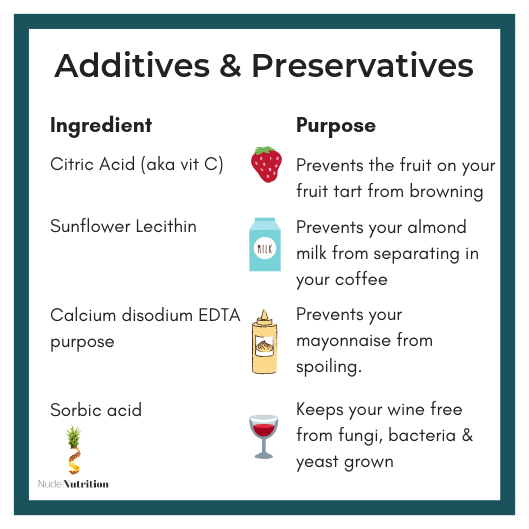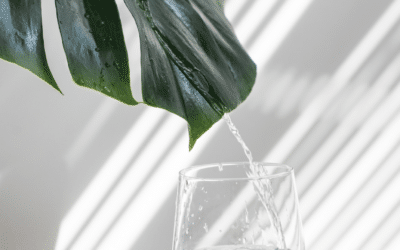Often, we hear that we should avoid all foods with additives and preservatives (aka chemicals).
Let’s be clear. This is virtually impossible, because:
a) all food contains chemicals
b) we as humans are made entirely of chemicals; and
c) we require chemicals to function! In fact, our very existence is due to thousands upon thousands of chemical reactions happening inside us right now which … you guessed it, need specific chemicals from food to be able to happen!
So, let’s look at exactly what the chemicals are in food and try to strip the nonsense.
Nude Nutrition Blog
How to stop food obsession
Firstly, there are naturally occurring chemicals in food, such as vitamins and minerals.
Secondly, there are synthetic chemicals made in a lab – these are often the additives and/preservatives we find in food.
We often fell that we should avoid additives and preservatives… particularly those ingredients with long scientific names that you can’t pronounce.
If we did that, then we’d be missing out on a lot of foods, or our foods just wouldn’t taste so great (as outlined in the image below).

Let’s look at some examples of additives and preservatives
- Take for example tocopherols and ascorbic acid (I.e. 3001, E3002, E3004) – if you saw these listed in the ingredients, what would your reaction be? They sound scary (particularly as one contains acid!) but in actual fact, these are just the chemical names for Vitamin E and Vitamin C which are commonly added to foods to help prevent microbial growth, and keep foods fresh, free from spoilage.
- Citric acid also sounds like one to avoid, but it is naturally found in citrus fruits and berries and used as a tart flavouring and decrease enzymatic browning of fruit.
- Now what about polyethylene and beeswax? Would you still eat something with these two ingredients? Well, these are used as edible coatings on fruit and vegetables to increase shelf life (1).
- What about guar gum, xanthan gum or pectin? Would you eat those? These three chemicals are stabilisers used in cloudy fruit juice beverages to stop pulp settling at the bottom of the bottle (2).
- Lactic acid also sounds pretty scary, but it is simply the by–product of corn or cane sugar being fermented and it is used to add tang to frozen desserts or fruit drinks.
- There is a lot of negative hype around emulsifiers too, which is a substance used in foods like almond milk, ice-cream, mayonnaise, and salad dressings. It essentially stops the oil from separating so we can enjoy these wonderful foods! There are some studies conducted in mice that suggest the consumption of these could be linked with gut inflammation and the development of inflammatory bowel disease (3, 4, 5). However, we don’t have sound human studies to support these claims. More studies are currently underway in this space, and in particular, links between the gut bacteria and additives and preservatives. Based on the most up-to-date research, the Food Standards Agency (who are responsible for food safety and hygiene in the UK) deem emulsifiers safe in healthy individuals.
How much additives and preservatives are safe to consume?
Additives and preservatives are used in food production, but they are used at levels that are safe for human consumption. Having too much of anything is not good, for example dihydrogen monodioxide (aka water) is harmful in high levels and so too is sodium chloride (aka table salt).
The only additives for which evidence has shown a link with cancer are nitrites and nitrates, which are used as preservatives in processed meat such as ham, bacon and chorizo. Eating processed meat has been strongly associated with an increased risk of colorectal cancer (6), (7). (Note: The term ‘processed meat’ refers to meat that has been preserved, smoked, cured, salted, or has had chemical preservatives added).
So, it’s all about the quantity. That is why the amount of additives used in food is tightly regulated by the Food Standards Agency. Also, any additive must be listed in the ingredients list (in decreasing order of weight) if it performs a function, such as giving food its colour or preserves its shelf life.
Foods contain lots of additives and preservatives for a variety of reasons. They can come both naturally and synthetically and are not only important for killing or slowing down the growth of harmful bacteria, but can also act as a gelling agent, a thickener, a shortener, an emulsifier, a sweetener, yeast food… the list is endless (8).
So, should you still eat foods with additives and preservatives?
As it is all about the quantity consumed, it’s important to look at your overall dietary quality. If you have a diet high in processed foods that use a lot of additives and preservatives, then you may be missing out on fresh fruit and vegetables or fresh whole grains that are full of important vitamins and minerals.
However, if you use a jar of stir-in pasta sauce with a pot full of fresh vegetables and wholegrain pasta, then this small amount of additives in the sauce jar will not be an issue.
Essentially, unless you only eat fruit or vegetables that have been picked fresh, you’ll most likely be consuming foods with additives and preservatives. It’s about considering your overall dietary pattern and striking a balance between consumption of fresh produce and processed products. You can have your apple as well as your apple cake.

References
(1) Ruelas-Chacon, X., Contreras-Esquivel, J. C., Montañez, J., Aguilera-Carbo, A. F., Reyes-Vega, M. L., Peralta-Rodriguez, R. D., & Sanchéz-Brambila, G. (2017). Guar Gum as an Edible Coating for Enhancing Shelf-Life and Improving Postharvest Quality of Roma Tomato (Solanum lycopersicum L.). Journal of Food Quality, 2017, 1-9. doi:10.1155/2017/8608304
(2) Ashurst, P., Hargitt, R., & Palmer, F. (2017). Soft Drink and Fruit Juice Problems Solved. Cambridgeshire, England: Woodhead Publishing.
(3) Chassaing, B., Koren, O., Goodrich, J. K., Poole, A. C., Srinivasan, S., Ley, R. E., & Gewirtz, A. T. (2015). Dietary emulsifiers impact the mouse gut microbiota promoting colitis and metabolic syndrome. Nature, 519(7541), 92.
(4) Bhattacharyya, S., Shumard, T., Xie, H., Dodda, A., Varady, K. A., Feferman, L., … & Tobacman, J. K. (2017). A randomized trial of the effects of the no-carrageenan diet on ulcerative colitis disease activity. Nutrition and healthy aging, 4(2), 181-192.
(5) Levine, A., Boneh, R. S., & Wine, E. (2018). Evolving role of diet in the pathogenesis and treatment of inflammatory bowel diseases. Gut, 67(9), 1726-1738.
(6) World Cancer Research Fund. Colorectal (bowel) cancer. 2011.
(7) World Cancer Research Fund. Stomach cancer. 2016.
(8) Food Standards Agency, Food Additives, 9th January 2018, [Accessed on 19th February 2019], retrieved from https://www.food.gov.uk/safety-hygiene/food-additives.
Links to further resources:
- Food Standards Agency, list of approved additives and e-numbers. https://www.food.gov.uk/business-guidance/eu-approved-additives-and-e-numbers
- The Conversation. Busting myths on food additives. https://theconversation.com/busting-the-myth-that-all-food-additives-are-bad-a-quick-guide-for-label-readers-82883
- The conversation. Emulsifiers. https://theconversation.com/food-additives-and-chronic-disease-risk-what-role-do-emulsifiers-play-38492




